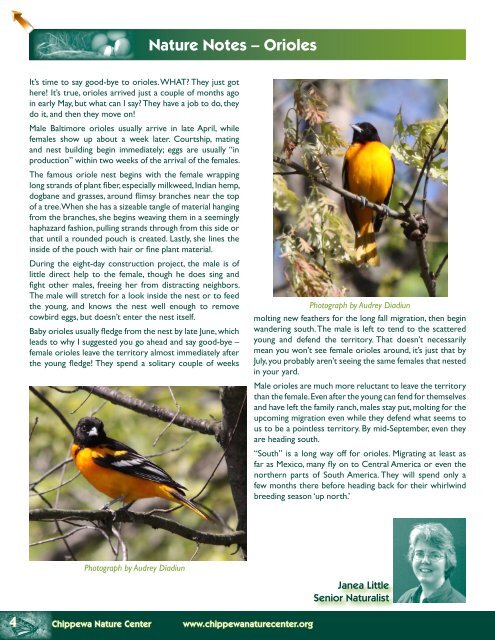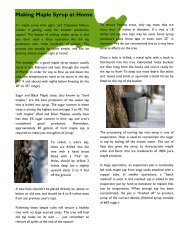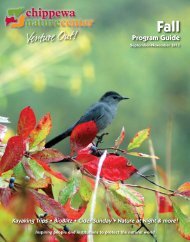You also want an ePaper? Increase the reach of your titles
YUMPU automatically turns print PDFs into web optimized ePapers that Google loves.
It’s time to say good-bye to orioles. WHAT? They just got<br />
here! It’s true, orioles arrived just a couple of months ago<br />
in early May, but what can I say? They have a job to do, they<br />
do it, and then they move on!<br />
Male Baltimore orioles usually arrive in late April, while<br />
females show up about a week later. Courtship, mating<br />
and nest building begin immediately; eggs are usually “in<br />
production” within two weeks of the arrival of the females.<br />
The famous oriole nest begins with the female wrapping<br />
long strands of plant fiber, especially milkweed, Indian hemp,<br />
dogbane and grasses, around flimsy branches near the top<br />
of a tree. When she has a sizeable tangle of material hanging<br />
from the branches, she begins weaving them in a seemingly<br />
haphazard fashion, pulling strands through from this side or<br />
that until a rounded pouch is created. Lastly, she lines the<br />
inside of the pouch with hair or fine plant material.<br />
During the eight-day construction project, the male is of<br />
little direct help to the female, though he does sing and<br />
fight other males, freeing her from distracting neighbors.<br />
The male will stretch for a look inside the nest or to feed<br />
the young, and knows the nest well enough to remove<br />
cowbird eggs, but doesn’t enter the nest itself.<br />
Baby orioles usually fledge from the nest by late June, which<br />
leads to why I suggested you go ahead and say good-bye –<br />
female orioles leave the territory almost immediately after<br />
the young fledge! They spend a solitary couple of weeks<br />
Photograph by Audrey Diadiun<br />
<strong>Nature</strong> Notes – Orioles<br />
4 <strong>Chippewa</strong> <strong>Nature</strong> <strong>Center</strong> www.chippewanaturecenter.org<br />
Photograph by Audrey Diadiun<br />
molting new feathers for the long fall migration, then begin<br />
wandering south. The male is left to tend to the scattered<br />
young and defend the territory. That doesn’t necessarily<br />
mean you won’t see female orioles around, it’s just that by<br />
<strong>July</strong>, you probably aren’t seeing the same females that nested<br />
in your yard.<br />
Male orioles are much more reluctant to leave the territory<br />
than the female. Even after the young can fend for themselves<br />
and have left the family ranch, males stay put, molting for the<br />
upcoming migration even while they defend what seems to<br />
us to be a pointless territory. By mid-September, even they<br />
are heading south.<br />
“South” is a long way off for orioles. Migrating at least as<br />
far as Mexico, many fly on to Central America or even the<br />
northern parts of South America. They will spend only a<br />
few months there before heading back for their whirlwind<br />
breeding season ‘up north.’<br />
Janea Little<br />
Senior Naturalist









